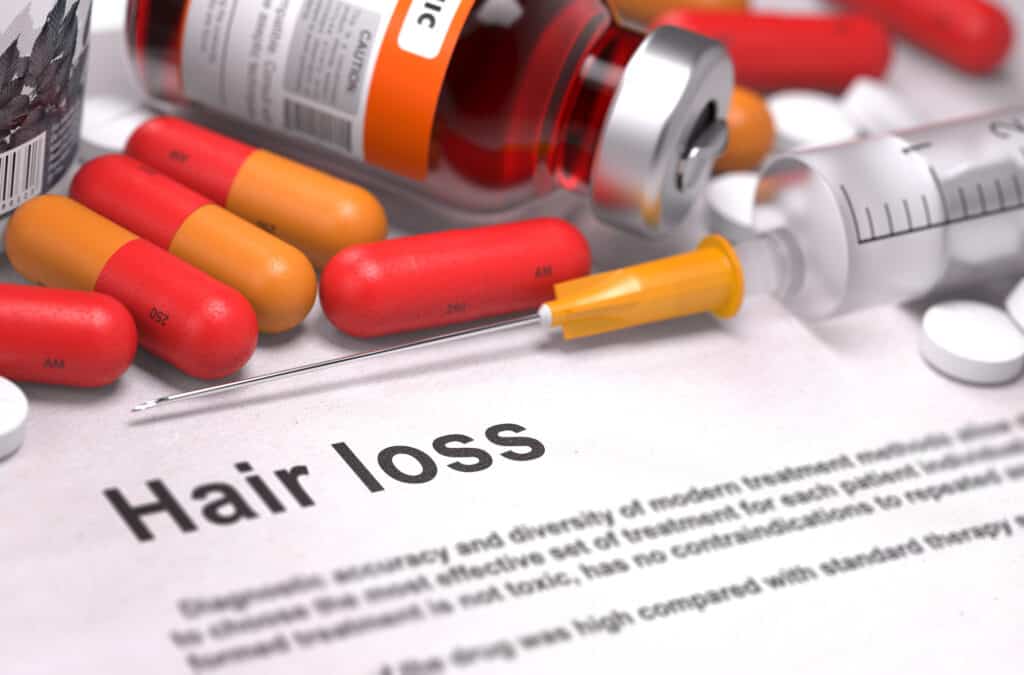EDITOR’S SUMMARY: With all of life’s hurdles, and finally understanding the concept of “letting go” to put peace of mind first, the unimaginable happens—your thick, full head of hair begins to dwindle. All life lessons are out the door while you panic … at least for a little while. Then you get to work to remedy the situation for which you affirm there is certainly a “cure,” or at least methods of improvement. Since you are unique in body composition and nutritional make-up, experimentation is called for. Start with the least toxic solutions—natural (non-synthetic) products, diet, and supplementation—and allow sufficient time for your hair to take the bait. Most situations in life can be enriched, and that includes the growth and health of your hair at any age.
By Brynnae Beekind
Hair holds a lot of weight. After all, it’s at the forefront of how you present yourself to others. So it goes without saying that feeling emotionally attached to your hair, particularly if you begin to lose it, may become even stronger. Becoming struck with this issue can create feelings of embarrassment, humiliation, worry, and put a damper on your self-esteem—all very stressful. More than 50% of women will experience hair loss or thinning at some point in their lives. You may begin to notice the difference in your locks as early as your 40s or 50s. This sudden change can be caused by a number of factors, including extended use of commercial hair dyes, medical conditions, such as autoimmune disorders, side effects from medications, pregnancy, and trauma.

The hair growth cycle is composed of three phases: anagen, catagen, and telogen. In the anagen stage, the follicle produces the fiber, and growth is seen through the scalp to the surface of the skin. The catagen stage marks the time period in which the hair sheds, and the dormant period with no hair growth from the follicle, characterizes the telogen stage. At any given time, you have hair follicles in each of these stages. If you have a lot of hair on your head, and you notice minimal loss while brushing and washing, most of your follicles are likely in the anagen phase. If you notice an excessive amount of hair loss that leads to a thinning mane, you may have a majority of follicles in both the catagen and telogen stages. At this time, the hair sheds and goes dormant, halting growth until the initial anagen phase begins again. For women with hair loss that does not grow back, such as balding areas, the follicle remains alive but is essentially stuck in the telogen phase.
It is not uncommon for acute hair thinning to arise due to stressful life events, poor diet, use of hair extensions, or decades of coloring and bleaching. A variety of medications may also cause hair loss: antibiotics, antidepressants, birth control pills, beta-blockers, cholesterol lowering drugs, and treatments for cancer. Loss of hair growth from these causes may be labeled a “disorder” called telogen effluvium (TE)—not otherwise harmful to your health, or indicative of serious illness. Hair thinning may also occur from male pattern baldness or female pattern hair loss. Baldness, largely due to heredity, refers to a large amount of hair loss from the scalp, revealing smooth skin in males, and excessive thinning to a visible scalp in females. Medically, this is termed androgenetic alopecia (also referred to as androgenic alopecia), and involves changes to the follicle that result in thinner hair shafts and shorter growth cycles.
Alopecia areata (AA) is another common term used to describe hair loss. This is a diagnosable autoimmune disease characterized by round patches of missing hair on the scalp, loss of additional body hair, and changes in your nails, such as small dents, white spots, or brittleness. In this case, your immune system attacks your hair follicles, causing hair to fall out. Luckily, it does not typically destroy the follicle. This means that if you are diagnosed with alopecia areata, you will likely be able to regrow your hair in time, but may have future flare-ups as hair is lost again. The risk of developing alopecia areata is relatively low, as an estimated 2% of the population may develop it in their lifetimes. Androgenetic alopecia, on the other hand, is the most commonly occurring reason for excessive hair loss. Sometimes telogen effluvium and androgenetic alopecia are diagnosed together.

Taking Actions to Grow, Grow, Grow …
While the appearance of thinning hair may cause personal and social distress, there are a variety of steps you may consider to reverse the trajectory. Treatment options for hair thinning vary widely based on many factors, and a good place to start is to understand the reasons behind your thinning. While androgenic alopecia can result in damaged follicles, you may choose to slow or prevent thinning from occurring by utilizing topical treatments containing U.S. Food and Drug Administration (FDA)-approved, minoxidil (brand name: Rogaine), or going so far as to undergo a hair transplant. Products containing minoxidil are generally recognized as safe, but with side effects such as headaches, low blood pressure, and shortness of breath, the Environmental Working Group (EWG) deems it unacceptable for use in “EWG Verified” products. Hair transplant surgery, where donor sites from a individual’s own scalp are grafted into areas of thinning, can cost anywhere from $4,000 to $50,000, depending on the number of hairs transplanted. While the process works wonderfully to restore hair for life, the cost can be exorbitant, and to boot, not everyone is a candidate, for reasons including medical conditions and lifestyle factors.
Splashed across social media marketing channels and T.V. commercials, numerous products, as well as cosmetic procedures are being advertised that claim to stimulate the process of hair growth. Take microneedling for example: An array of tiny needles are superficially rolled across your scalp, and platelet rich plasma (PRP) injections are given. These are touted as “non-invasive,” and intended to stimulate follicle growth. PRP has shown clinically-significant results for women experiencing extreme hair thinning in female pattern hair loss, leading to a greater quality of life in some cases.However, hair stimulation methods performed in medical settings have their drawbacks, including patient anxiety, cost, time, and recovery periods. Given the skepticism, people are enticed to seek simple, affordable treatments to derail the loss of their tresses.

Red light therapy, dermarollers, medication-free vitamin formulas, and various biotin-heavy mixes, including specialty shampoos are popular. As such, exploration of their safety and efficacy is needed. Red light therapy is a treatment that exposes red light from a bulb or other device to your scalp. It has promising results, no side effects, and can be applied in the comfort of your home for a modest price. A dermaroller is a type of microneedling that stimulates blood flow, reportedly having the potential to help hair remain in the growth phase for longer periods of time. Note that some users claim their hair gets caught in the roller, and subsequently gets pulled out. Supplementing with generous amounts of biotin, a B vitamin linked to increased metabolism of amino acids, can improve hair growth. Herbal-rich products containing rosemary oil, ginseng, red clover, stinging nettle, lavender, or hibiscus can also be useful for kickstarting the process of hair regeneration. Care should be taken to ensure supplementation is from organic, whole food/herb sources, to help maintain bioavailability, avoid synthetic toxins, and get the best bang for your buck. In Ayurvedic medicine, hibiscus is used in a variety of ways to enhance hair growth. From “7 Ways to Use Hibiscus For Healthy Hair”:
“According to Ayurveda, hair loss is usually caused by damage to the hair follicles due to excessive body heat. The cooling properties of Hibiscus make it an excellent Pitta-balancing herb, which is beneficial for hair fall and regrowth-related issues. Furthermore, the amino acids in Hibiscus flowers provide the hair with the nutrients that help stimulate hair growth. These amino acids produce the structural protein called keratin, which is the building block of hair. So if you are looking to incorporate Hibiscus for hair benefits, this herb nourishes, strengthens, and binds the hair roots, making them less prone to breakage.”
And from Medical News Today, “How to use rosemary oil for hair growth”:
“A 2015 study found that rosemary oil may be a useful treatment for androgenic alopecia. The participants of the study showed a significant increase in hair count after 6 months of using rosemary oil. The overall result of the study provided evidence that rosemary oil may be effective for certain hair growth.”

Experiment and Become a Smart Investigator
While a variety of hair growth brands promise positive results without the use of toxic chemicals, don’t take their word at face (marketing) value. It may take some digging to find a product’s full list of ingredients, and upon inspection, don’t be surprised to find it isn’t as clean as the manufacturer claimed it to be. For instance, a popular shampoo bar from one company contains behentrimonium methosulfate (BTMS-50 MB), an ingredient that can cause moderate immunotoxicity and organ system toxicity, according to the Environmental Working Group (EWG). Synthetic fragrances that disrupt hormones are also found in shampoo bars marketed for healthy hair growth. Additionally, toxic skin irritants like benzoic acid and propylene glycol are consistently used in hair growth products.
Be alert when you source, as a product claiming to be natural doesn’t mean it’s made with non-toxic ingredients. Just because a product says “organic,” doesn’t mean that all or even most of the ingredients are organically-derived. Read each and every ingredient, and look for verified labels, such as USDA organic, or other recognized third-parties. A product that is effective for hair survival doesn’t mean it won’t have health risks down the road. A handful of the main ingredients to stay away from include synthetic fragrances, formaldehyde, parabens, phthalates, sodium lauryl sulfate, and propylene glycol. Ingredients such as these may be generally recognized as safe by the FDA, making them available for manufacturers to use. And while minimal use may not present a problem initially, long-term use is unknown at best, and disease-contributing at worst.
If your hair loss stems from overprocessing with dyes or extensions, the best way to stop the thinning is to stop these practices. If thinning is due to medications, you may want to discuss alternative treatments with your integrative practitioner. Cutting out gluten foods may be worth considering, as there’s evidence that celiac disease (autoimmune disorder) may cause hair loss. Of the many routes you can take to remedy thinning hair, from dietary upgrades to non-toxic products, to surgical procedures, try to stick with the intervention(s) you choose for at least three months, and track your progress along the way. Implementing natural, affordable solutions like whole-food, vitamin/mineral supplementation, and at-home treatments, such as toxin-free shampoos, rinses, and scalp stimulating brushes may empower you, while curtailing the shadowy aspects of worry and fear that can loom heavy under these circumstances.
Nutritional issues such as vitamin and mineral deficiencies can be dealt with by identifying the problem and adjusting your diet, or adding supplementation as needed. Iron, zinc, niacin, omega-3, selenium, vitamins D, A, E, biotin, folate, and amino acids have been linked to hair health, and subsequent loss if levels are inadequate. Acute, short-lived stress, such as chaotic project deadlines at work, or personal loss, can cause hair thinning that generally resolves on its own after several months, so long as the stress doesn’t become chronic. In such cases, incorporating stress-reduction practices, such as deep breathing, cold water therapy, meditation, or yoga can be supportive.
~
Published on August 15, 2024.
If you’ve found value in this article, please share it!
To support the research and health education of AVFC editorial, please consider making a donation today. Thank you.

